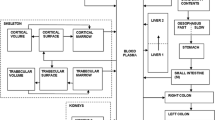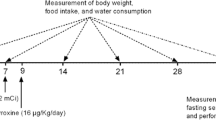Abstract
The activable enriched stable isotope Cr-50 compound Cr2O3 was used as a tracer to study the metabolism of chromium(III) [CR(III)] intragastrically administered in normal and diabetic rats. The comparison of absorption, distribution, and excretion in organs and tissues of the two groups do not show much alteration, but some differences exist indeed. The contents of51Cr radioactivity of the diabetic rats appear to be of higher retention than in most studied organisms. The urinary51Cr excretion of diabetics is significantly higher than that of normal rats. Therefore, a conclusion can be drawn that the insulin-dependent rats generally absorb and excrete more chromium (Cr) than the normal rats.
Similar content being viewed by others
References
K. Schwarz and W. Mertz, Chormium (III) and the glucose tolerance factor,Arch. Biochem. Biophys. 85, 292–295 (1965).
R. O. Brown, S. Fourloines-Lynn, R. E. Cross, and W. D. Heizer, Chromium deficiency after long-term total parenteral nutrition,Dig. Dis. Sci. 31, 661–664 (1986).
H. Freund, S. Atamian, and J. E. Fischer, Chromium deficiency during total parenteral nutrition,J. Am. Med Assoc. 241, 496–498 (1979).
K. N. Jeejebhoy, R. C. Chur, E. Marliss, G. R. Greenberg, and A. Bruce-Robertson, Chromium deficiency, glucose intolerance and neuropathy reversed by chromium supplementation in a patient receiving long-term total parenteral nutrition,Am. J. Clin. Nutr. 30, 531–538 (1977).
M. J. Uusitupa, L. Mykkanen, O. Sütonen, M. Laakso, H. Sarlund, P. Kolehmainen et al. Chromium supplementation in impaired glucose tolerance of elderly: effects on blood glucose, plasma insulin, C-peptide and lipid levels,Br. J. Nutr. 68, 209–216 (1992).
P. R. Shepherd, C. Elwood, P. D. Buckley, and L. F. Blackwell, Glucose tolerance factor potentiation of insulin action in adipocytes from rats raised in a torula yeast diet cannot be attributed to a deficiency of chromium or glucose tolerance factor activity in the diet,Biol. Trace Element Res. 32, 109–113 (1992).
B. W. Morris, T. A. Gray, and S. Macneil, Glucose-dependent uptake of chromium in human and rat insulin-sensitive tissues,Clin. Sci. 84, 477–482 (1993).
H. J. Dowling, E. G. Offenbacher, and F. X. PI-Sunyer, Absorption of inorganic, trivalent chromium from the vascularly perfused rat small intestine,J. Nutr. 119, 1138–1145 (1989).
W. Y. Feng, W. J. Ding, Q. F. Qian, and Z. F. Chai, Study the metabolism of chromium in rats by51Cr tracer technique,Nuclear Tech. (in Chinese, accepted) (1998).
R. A. Anderson and M. M. Polansky, Dietary and metabolite effects on trivalent chromium retention and distribution in rats,Biol. Trace Element Res. 50, 97–108, (1995).
R. J. Doisy, Metabolism of51chromium in human subjects—normal, elderly and diabetic subjects, inNewer Tracer Elements in Nutrition, W. Mertz, and W. Cornatzer, eds., Dekker, New York, pp. 155–168 (1971).
T. H. Lim, T. Sargent III, and N. Kusubov, Kinetics of tracer element chromium (III) in the human body,Am. J. Physiol. 244, R445-R454 (1983).
S. Wallach and R. Verch, Radiochromium distrition distribution in aged rats,J. Am. Coll. Nutr. 5, 291 (1986).
Z. N. Song, The epidemiology of diabetes in China, inApplied Diabetes, G. Y. Giang, ed., The People’s Medical Publishing House, Beijing, pp. 1–22 (1996).
F. E. Rossetto and E. Nieboer, The interaction of metal ions with synthetic DNA: induction of conformational and structural transitions,J. Inorg. Biochem. 54, 167–186 (1994).
T. S. Elizabeth, Effects of chromium in DNA replication in vitro,Environ. Health Perspect 102 (Suppl. 3), 41–44 (1994).
N. E. Craft and M. L. Failla, Zinc, iron and copper absorption in the stretpozotocin diabetic rat,Am. J. Physiol. 244, E122-E128 (1983).
I. Raz, J. H. Adler and E. Havivi, Altered tissue content of trace metals in diabetic hyperinsulinaemic sand rats (psammomys obesus),Diabetologia 31, 329–333 (1988).
M. L. Failla and C. Y. R. Gardll, Influence of spontaneous diabetes on tissue status of zinc, copper and managenese in the BB Wistar rats,Proc. Soc. Exp. Biol. Med. 180, 317–322 (1985).
A. L. Lau and M. L. Failla, Urinary excretion of zinc, copper, and iron in the streptozotocin-diabetic rat,J. Nutr. 114, 224–233 (1984).
Author information
Authors and Affiliations
Rights and permissions
About this article
Cite this article
Feng, W., Ding, W., Qian, Q. et al. Use of the enriched stable isotope Cr-50 as a tracer to study the metabolism of chromium (III) in normal and diabetic rats. Biol Trace Elem Res 63, 129–138 (1998). https://doi.org/10.1007/BF02778872
Received:
Revised:
Issue Date:
DOI: https://doi.org/10.1007/BF02778872




